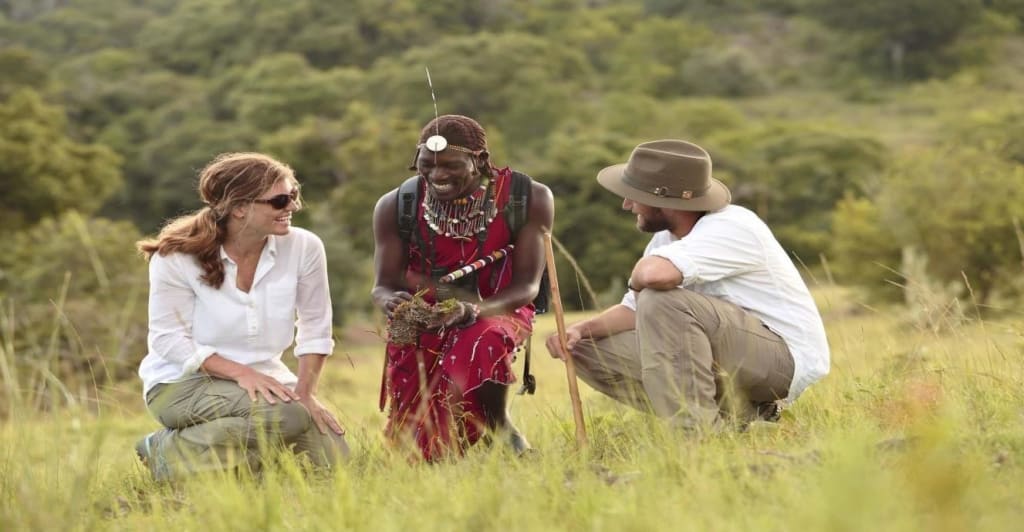The Patriarchal Nature of the Maasai Culture
The Maasai Culture

The Maasai prides itself as the only tribe that has remained loyal to its traditional way of life despite the influences posed by education, civilization, Christianity and western cultural practices. The Maasai people still stand proud in the savannah in their red blankets many years after western culture invaded East Africa. They are in fact considered a very important symbol among the more liberal tribes. The Maasai shield is featured in the Kenyan National flag, a symbol that they are considered a national treasure. It is quite common in Kenya and Tanzania to see the Maasai In their traditional dress not only in their villages but in the city streets as well.
The Maasai population is estimated to be about 800,000 in Kenya with a possible same number in Tanzania. They are found in southern Kenya and Northern Tanzania where most of the major national parks and game reserves are found. They are pastoralists and lead a nomadic lifestyle in search of pasture for their animals. Serengeti and Ngoro Ngoro in Tanzania and Maasai Mara in Kenya have known tourist sites and game reserves named after the Maa or Maasai language. It is not uncommon to find Maasai Morans fight off wild animals which often prey on their animals since they live near parks.
It is for this reason that tourists often troop to these areas as they try to know how they live in the savannah and how their lifestyle is in these semi-arid areas. Hardly can you find these Nilotic nomads in rainy or hilly areas. During tourist trips, you often will come across groups of the red-dressed Maa speaking people in the hot savannah trekking for long distances, unaware of the possible dangers of being attacked by wild animals.
The Maasai people are said to have originated from South Sudan. Their Maa language is the southernmost of the Nilotic groups including phrases and idioms spoken in Ethiopia and Sudan. Historical records indicate that the Maasai people migrated into their current homeland in southern Kenya and Northern Tanzania in the late 17th century and early 18th century, displacing some of the tribes who had previously settled in the region while others got assimilated into their culture. While their main activity is cattle raising, the Maasai people have also been known for centuries to be fearsome and brave hunters. Kenya National news records show instances in which individuals from the Maa speaking group wrestled with lions and were able to kill them.
Between 1883 and 1902 there came the darkest era of the Maa-speaking people. It was known as emutai in the Maa language which meant wipe out. This the period in which 60% of the Maasai lost their lives as a result of smallpox, drought and starvation. Records show that they were hard-hit, and the deaths were catastrophic so that carcasses were found lying in the open fields where they used to grace their animals. It was also around the same time that rinderpest wiped out their animals, exposing them to starvation since their main source of livelihood is cattle raising.
In the beginning of the 20th century, the government through the ministry of Tourism oversaw the turning of vast sections of Maasai land into game parks and wildlife reserves. The Maasai, being nomadic in nature, were not pleased by the government move. During the same period, the government through the new education policy, pressured the Maasai to give up their traditional nomadic lifestyle in favour of farming and a more sedentary lifestyle. This was not to be since the Maasai culture revers animals above any other activity.
Up to today, the Maasai people have resisted the government pressure to settle in permanent homes, and have distanced themselves from urban areas. They have continued to practice their traditional lifestyle which has remained unchanged for centuries.
Despite all these, a section of the Maasai have opted to pursue mainstream education and have moved to cities becoming lawyers, doctors and politicians. Not only so, the majority of the Maasai are now practicing farming in areas like Loiktoktok where, by the help of migrants from other tribes, they have learnt the art of farming.
The Maasai Culture
The Maasai culture is predominantly patriarchal, with a council of elders overseeing the daily running of the village and administering matters on the basis of an oral body of law. Execution and slavery are unknown in Maasai society, and disputes are usually settled via cattle payment.
Cattle herding is still the main activity of Maasai people, and cattle is central to their lifestyle. Traditionally, the Maasai diet consists mainly of raw meat, raw blood, and milk. Leather is used to fashion Maasai shields. Wealth is measured by the number of children and cattle you have: A man with many children, but not much cattle is considered poor (and vice versa).
Another important aspect of Maasai culture is the warrior caste, which is known in Maa as ilmurrain. A new group of soldiers is initiated every 15 years or so, chosen among young men ages 12 to 25. These men undergo a strict training period that culminates with a series of initiation rites, the most important of which is circumcision. It’s carried out with traditional instruments and no anaesthetic: The ability to withstand pain is part of the young warriors’ transition to manhood.
The Maasai are monotheistic in their belief and their worship is centred on Enkai, the deity that has a dual nature--both benevolent and vengeful. The most important figure among the Maasai religion was Laibon who was a priest and Shaman, whose role traditionally included healing, divination and prophecy. Today laibon plays a political role since most of them belong to the Maasai council of elders.
Maasai people are generally polygamous. The woman doe not only marry her husband but his entire age group as well. It is not uncommon to find a spear dug into the ground in front of manyatta, the traditional Maasai hut as a sign an age group is fulfilling marital rights in the hut. Traditionally, a man was expected to give up his bed for a visiting male guest. Though this culture is slowly fading out, it is still common for the woman of the house to join her guest in bed if she so desires.
There have been rigorous campaigns against the Maasai culture of female mutilation. Despite these campaigns, female genital mutilation is still being practised secretly because of law enforcement agencies getting stiff with the traditionalists. At some point there often occurs confrontation with the law as the Maasai diehards insist on carrying out the age-old culture.
The practice, fortunately, is decreasing, thanks to the activist campaigns, and is being replaced by the symbolic cutting which is characterized by songs and dances rather than blade-cutting.
The Maasai women are meant to procreate children who then are introduced to cattle raising as soon as they are able to walk. Babies are not named until they are three months of age because of the high infant mortality rate in the past.
The Maasai Cultural Dressing
Traditionally, Maasai women wear Shuka, a sheet of fabric which is worn wrapped around the body. The colour of the attire usually varies according to age and gender. Of course, there are distinct differences between the gender and age groups. For example, young men do wear black colour immediately after circumcision for several months before moving to the next age set. Old men, on the other hand, do wear red wraparounds while women wear checked, striped or patterned piece of cloths.
The Maasai men also clean-shave their hair as a passage of rite especially circumcision and marriage. The Maasai warriors are the only ones allowed to let their hair grow which are plaited in thin braids and coloured.
They also pierce and stretch their earlobes using stone wood and bones. They usually wear beaded earrings on the pierced and stretched earlobes. Traditionally, both gender stretches their earlobes because stretched earlobe was seen as a symbol of wisdom and respect. They also remove the canine teeth in early childhood as a remedy against diarrhoea and vomiting especially when they have to administer medicine to stuck-out stiff mouth. Lacked jaws often prompted the removal of the two lower teeth to provide a means of feeding the victim.
The jumping style of dance of the Maasai is another one of their culture that would awaken a theatre-hall to hilarious jubilation. The dancing is carried by the warriors and involves calculated self-raising into the air and back at a rhythm of the adumu or aigus. They form a semi-circle and take turns jumping at the centre, as high as possible, without letting their heels touch the ground. As they take the turn to jump, the others sing a high-pitched song whose tone depends on the height of the jump.
Traditional Maasai music uses a given pattern called namba. This is a call-and-response pattern where the vocalist known as olanyarani sings the melody and the chorus responds in unison. The music is accompanied by body movements, tilting and the head jerking back and forth.
The Maasai Language
Maa, is a Nilotic language spoken in northern Tanzania and southern Kenya. The Maasai are the only tribe that has shielded itself from the encroachment of westernization of agriculture and colonization primarily because they occupy a desert area. Since they have resisted all forms of colonization and western expansion, their communication systems revolve around trade they do within the tribe. Therefore, their language is not only their most significant point of contact but also one of the only ways that Maasai can continue to thrive in their traditional tribal life.
The Maasai way of life is strongly embedded in their language, especially the economic systems of trade that the Maasai rely on in order to sustain their nomadic way of life. They heavily rely on the integration of their language to mingle and sell their goods which include beaded products such as belts, earrings, necklaces and other body modifiers which are cleverly crafted by Maasai women. They then will approach their potential customers through the Maa language before they inject Kiswahili or English into the conversation.
The Maasai women who do trade in urban centres, though they have no formal education, have mastered the art of communicating in English to foreign white customers. So even though there has been a loss of the Maa language, it has not been rapid since it is a very strong point of contact between the Maasai and foreigners which include even the tourists.
The Maasai, therefore, will continue for a long time in the future to nurture their culture. The Maasai culture is deeply entrenched and with other tribes moving to live among them, the degree of assimilation to common cultural practices is very slow.
About the Creator
pius Ratugi
I write as a hobby, I write for money, I write for the community; to instill integrity and save our environment. As you read this short bio, I want you to know that my reason for excelling as a writer is because I’m nuts about knowledge;






Comments
There are no comments for this story
Be the first to respond and start the conversation.